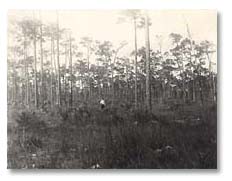|
 Pinelands
on the edge of the Everglades
Pinelands
on the edge of the Everglades
The Everglades is the ecological heart of the state of Florida. Prior to
European colonization in the sixteenth century, much of the land in central and
southern Florida was dominated by tidal marshes, mangrove swamp, hardwood
groves, and saw grass.
Pioneering Everglades conservationist Marjory Stoneman
Douglas would call this ecosystem "the river of grass," and it was largely through
efforts of dedicated environmentalists like her that the Everglades was not
completely destroyed.
Stretching one hundred miles from Lake Okeechobee to the Gulf of
Mexico, and from fifty to seventy miles wide, the Everglades and its
surroundings were home to several Native American tribes, including the
Tequesta, the Mayaimi, the Calusa, and eventually the Seminole. Yet the
widespread project of draining the Everglades following the admission of the
state of Florida to the Union in 1845 threatened not only the survival of the
tribes but also the future health of the ecosystem.
|
|



